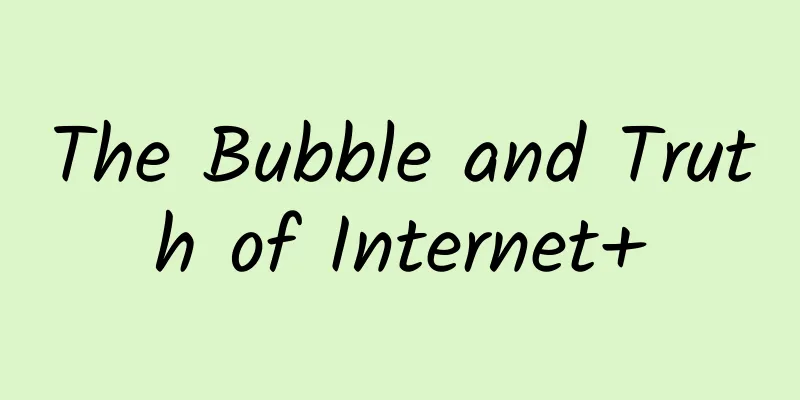The Bubble and Truth of Internet+

|
Since the release of the government report at the 2015 Two Sessions, "Internet+" has become a popular concept. In the TMT investment field, every report mentions Internet+, and no investment target is considered unless it is Internet+. For a time, bubbles were rampant, all kinds of monsters and demons appeared on the streets, and stock prices soared like a runaway horse, completely disregarding the basic laws of value. There is no doubt that Internet+ is the trend of the times. However, facing the market frenzy and various uncalmness, we must calm down, think about the truth of Internet+, and look for the real gold under the bubble. There are two types of Internet+ on the market The first is Internet + Industry, which aims to transform the traditional production model through Internet technology and thus boost the sluggish economy; The second is to stimulate information consumption, aiming to transform the circulation model through e-commerce, promote the growth of domestic and foreign demand, and promote social employment. The second type is Internet+ proposed by Internet companies, which is characterized by light assets + services. After the two sessions, there are two main schools of thought: One group is Tencent+. According to Ma Huateng's statement of "connecting everything", it can be understood as connecting public services through QQ and WeChat platforms to improve social operation efficiency. They hope that the government can share data and allow people to use WeChat to handle things that require going to the government (such as WeChat visas), thereby enhancing user stickiness. The other is Alibaba+. Alibaba has been promoting a concept that cloud computing is a necessity for future humans, just like water and electricity. Its purpose is to promote cloud computing, hoping that small and medium-sized enterprises, various organizations and even governments at all levels will access its cloud computing and thus improve their own big data resources. If you look more closely, you will find that both Alibaba and Tencent are aiming at a common goal: big data resources. Why? As the viewpoint put forward at the CITIC Securities Strategy Conference last summer: in a few years, there will be no Internet companies in the world, only data companies, and the "quantity and quality" of data owned by a company will determine the value of the company. 1. Throw a bucket of ice water first: Four truths 1. Truth: my country’s ICT development level is low and Internet penetration needs to be improved Why is no one talking about Internet+ in developed countries in Europe and America? The answer is simple: there is no need. In the United States, Japan and other countries, the Internet and related industries have become one of the most dynamic and largest industries, and have become an important driving force for sustainable economic development. The proportion of related industries in their GDP has reached or exceeded 50%, and the contribution rate to the added value of GDP far exceeds that of the first and second industries, becoming an important driving force for creating jobs. In comparison, my country's ICT level is still not high, at least 10 years behind Europe and the United States. In the 2014 "Measuring the Information Society Report" released by the International Telecommunication Union (ITU), China's ICT level ranked 86th. 2. The truth: A world without Internet access is not your cup of tea Some traditional domestic companies are trying out Internet+, often considering China's 1.3 billion population as their potential market. In fact, this is a trap. Because the Internet has divided Chinese society into two worlds: the Internet-connected and the non-Internet-connected. The national Internet penetration rate is 47.9%, which means that more than half of the population is still outside the Internet world. Traditional companies doing Internet+ business, such as mobile games, online education or online travel and other hot industries, are mainly suitable for developing the existing market in the Internet world, while the non-Internet world is a potential undeveloped market (the development cycle may take 20 years). It would be naive to confuse the two. 3. The truth: Domestic technological innovation is mostly C2C, lacking originality, and is at the downstream of the industry The Internet is a typical representative of high-tech industries. Its early start has enabled developed Internet countries in Europe and the United States to take the lead in industrial development. Since these countries have mastered core technologies, they have firmly controlled the development of related fields. In comparison, China is still at the downstream of the industry. What is "developed" in China is Internet applications rather than core technologies. Since these core technologies are all "learned" from the United States, there is a saying in the industry that C2C is "Copy2China". Although after 20 years of development, new advantages have been formed in certain application technologies, but overall, my country's local Internet technology innovation is mainly focused on the improvement and improvement of applications. Except for a few giant companies, there is little involvement in the research and development of core technologies. 4. The truth: my country’s Internet companies have relatively low technological innovation capabilities For Internet companies, technological innovation is an important driving force for corporate growth. In fact, the overall technological capabilities of local TMT companies are lower than those of their foreign counterparts. Under this premise, domestic Internet leaders that have grown up and companies with certain innovation capabilities have all gone overseas to list. Most of those who remain in the A-share market are the disadvantaged groups in the industry, resulting in the phenomenon of "first-class companies going overseas, and second- and third-rate companies going to A-shares." But what is surprising is that the attention these companies receive is far higher than their overseas counterparts. What's even more surprising is that some traditional business companies have quickly obtained high premiums simply because they have been labeled as Internet or Internet+, and their market value has expanded and floated into the air. I'm just wondering, isn't this a bubble? 2. Internet+: A new round of bubble is brewing 1. Who says there is no bubble? When I mention bubbles, I think of the tragedy 15 years ago. In 1999, the website I worked for was full of confidence in preparing for an IPO, but I didn't expect that in the summer of 2000, it began to adjust its strategy, and then it began to shrink its strategy. Many colleagues in marketing, sales, editing, technology... disappeared. On March 10, 2000, the Nasdaq index reached a high of 5132.52, and then fell all the way; during this period, 210 ".com" companies in the United States went bankrupt, and hundreds of billions of market value evaporated in an instant. Recently, the Nasdaq index has returned to 5,000 points, and A-shares have also risen. Does this mean the advent of another Internet bubble? In this regard, it is necessary for us to analyze that the current rise of Internet+ has many similarities and differences compared with the Internet bubble in 2000. The first similarity is that both rose in a bull market. However, the formation of the Nasdaq bull market was based on the strengthening of the US economy, while the background of the A-share bull market was the downward trend of the macro economy and the lack of overall economic growth momentum. From this point of view, the possibility of domestic bubble is greater. The second similar situation is that the valuations are frighteningly high. Back then, the valuations of a lot of technology stocks seemed unreasonably high. At the peak, the price-earnings ratio of Nasdaq was as high as 100 times. In the A-share market, the price-earnings ratios of companies in the TMT field are now close to 100 times, and some are hundreds of times, even far exceeding the situation of Nasdaq back then. Unlike Nasdaq, Nasdaq gathered the world's best technology companies back then. The quality of several companies in the A-share market is still quite different from that of Nasdaq. The third similar situation is that venture capital is concentrated in large quantities. The amount of venture capital is almost a weather vane for whether there is a bubble or not. The larger the amount of venture capital, the greater the possibility of a bubble. According to a survey report by Venture Source, China's venture capital in 2014 has jumped to second place in the world, second only to the United States. The increasing amount of venture capital cannot but increase people's concerns about bubbles. Unlike 15 years ago, the current scale of the Internet is 15 times larger than in the past. In 2000, there were only 200 million Internet users in the world, but now there are 3 billion Internet users in the world. Among them, the number of Internet users in China is as high as 649 million, which is more than twice the total population of the United States. Obviously, the global Internet and high-tech industries will not necessarily encounter a bubble burst like in 2000. In the long run, the Internet is still an industry with relatively broad prospects. However, we must also be aware of the risks. After the rise of the domestic Internet+, the Chinese stock market is not short of concept speculation and theme-driven companies, nor is it short of companies that have transformed from catering to cloud computing. What is lacking is mainstream platform-level Internet companies and Internet companies that have mastered unique core technologies. Therefore, our focus should be on how to "squeeze out the bubble", how to discover the truly powerful companies that exist under the bubble, and be careful to bypass those companies wearing Internet+ vests. 2. Why is it worth looking forward to in the long term? The existence of bubbles does not mean that they will burst. The Internet is worth looking forward to in the long term because it shoulders a major political mission. The first appearance of "Internet +" in the government report was actually ordered in times of crisis - the macro-economy continued to deteriorate, and economic growth needed a new engine. At present, my country's economy has entered a stage of medium-to-low-speed growth from a high-speed growth stage. From the perspective of GDP, my country's GDP growth rate has dropped from 14.5% in the first quarter of 2007 to 7.3% in the fourth quarter of 2014, and my country's exports have also shown a weak trend. In addition, the problem of overcapacity in the manufacturing sector is still prominent, and my country urgently needs to find a new engine for the economy. The government has noticed that the Internet economy is growing rapidly, which has a positive effect on promoting circulation, expanding consumption, and benefiting people's livelihood. It has also realized the importance of leading Internet companies. Compared with the 2014 government report, it can be found that the importance and basic nature of the Internet have been significantly improved, which not only shows that the government's understanding of the Internet has deepened, but also shows that the Internet has been upgraded to a national leading industry in the government's mind. It can be expected that the relevant institutional dividends will be further released with the deepening of administrative reforms. 3. With good and bad mixed together, how to identify the real and fake Internet+? The top level has already been stirred up, and we have reason to believe that for quite a long time to come, various "Internet +" action plans will emerge in large numbers from governments at all levels and in all regions. The enthusiasm for innovation and entrepreneurship in the whole society will be greatly released, and the public environment for the development of the Internet will also be improved. I would like to propose a new framework of understanding: the impact of Internet technology on traditional industries is currently concentrated in the transformation of production models and circulation models. The former relies more on IOT technology, while the latter relies on e-commerce. Internet+ is a new form of enterprise that combines the advantages of both the Internet and traditional enterprises, but not all enterprises will adopt Internet+, at least not yet. 1. Not all enterprises need Internet+ Which companies are suitable for Internet+ and which companies do not need Internet+? We must first analyze the characteristics of the industry needs of companies. Currently, the Internet has gradually penetrated into social and economic life. Different companies are more or less involved in the Internet. According to the degree of Internet demand of different companies, we can divide companies into four categories: 1. Off-network enterprises: enterprises that have no access to the Internet and still use more traditional off-network production and distribution methods. Such enterprises may have an information technology foundation, but their business has little to do with the Internet, such as the construction and mining industries. The credibility of such enterprises in implementing Internet+ is very low. 2 Marginal enterprises: These are Internet marginal enterprises. These enterprises can be Internet companies or traditional industry companies with good informatization foundation. For the latter, their main business relies on offline resources and they begin to try Internet technology for marketing. Such enterprises have a high willingness to adopt Internet+, such as catering and medical care. The implementation effect is high, but the risk is high. 3 ICT enterprises: enterprises that provide sensor technology, communication services and equipment, computer software and hardware products, etc., with a high degree of Internetization in production and operation, such as software and hardware companies, IT solution providers, and telecom operators; these enterprises have a high willingness to adopt Internet+, low risk, and mainly focus on existing customers and market transformation, and have not yet made large-scale cross-border efforts. In recent years, a small number of emerging enterprises have begun to penetrate other traditional industries, and their businesses are mainly based on providing information systems rather than Internet+. 4 Internet companies: Companies that operate on the Internet, such as BAT and other companies, survive entirely on the Internet. These companies penetrate traditional industries, which helps to rapidly expand their market coverage and have the highest willingness to actively implement Internet+. However, it is very difficult and risky for Internet companies to cross over into a new field. Among the above four types of enterprises, marginal enterprises are the most anxious. These traditional enterprises have an urgent need to integrate into the Internet, but often do not know how to take action. The second is Internet companies. These two types of enterprises are the direction of the Internet+ in the government report and are also the focus of social attention. However, non-Internet enterprises and many ICT companies are the soil for the existence of bubbles. Among these four types of companies, we need to pay more attention to anxious marginal businesses and Internet giants. 2. Marginal enterprises: How do you not feel anxious? The essence of Internet+ is not a simple module superposition, but a qualitative change. To relieve the anxiety of Internet+, marginal enterprises need to go through at least three stages: The first stage is to transform circulation: realize the Internet-based sales, promote the company's products and services in an e-commerce model, and carry out online marketing; The second stage is to transform production: adjust production management and operation, and use Internet concepts (such as user-centricity) to transform the system to adapt to the needs of Internet operations; The third stage is industrial collaboration: enterprises can realize the Internetization of the supply chain and gradually achieve industrial collaboration. In this stage, enterprises can form their own ecosystem around their own business, or join the ecosystem of others. At present, many listed companies in traditional industries in China are focusing on the first stage of "Internet +". Many people think that opening up an e-commerce platform or conducting online marketing is equivalent to realizing Internet +. This is a rather dangerous perception and is one of the important reasons for the high failure rate. This is because most of these companies are industry leaders with large scale and mature business models, making transformation difficult. Internet+ requires a complete system transformation. If companies only regard e-commerce as a new business channel, or regard Internet business as a new business module rather than a strategic direction, they will inevitably compete with their own offline channels, resulting in a left-hand-right hand competition, which will lead to huge internal resource consumption and make it difficult for new businesses to survive the growth period with investment but no output. To become a true Internet+ company, you must have at least four qualities: technology, data, model and organization. First, from the perspective of technical quality, Internet technology and applications have penetrated from the service industry to industry and agriculture. The three traditional industries are currently in the transition period from the 2.0 stage to the 3.0 stage. Marginal enterprises in different industries can use Internet technology innovation to drive production and change circulation. For example, farms use IOT technology to strengthen agricultural management, factories use intelligent production tools such as CPS to support enterprises to produce more efficiently, and restaurants use mobile Internet technology to arrange Internet orders. Software uses more artificial intelligence technology, hardware uses a large number of robots, and everything is connected by intelligent chips. People, objects, processes and data will be integrated through the Internet. Secondly, from the perspective of data quality, data analysis can drive the business management decisions of the enterprise. Enterprises that use cloud computing will accumulate a large amount of operational data. These data come from customers, suppliers, and various production and management departments within the enterprise. Using relevant data analysis tools will help business decision-making, predict market changes, and make quick responses. In the future, with more data and more efficient data processing tools, the value of enterprises will be higher. Thirdly, from the perspective of model quality, current enterprises can "combine" offline resources through Internet platforms and online marketing platforms. Among them, C2B is a new model with vitality. Its core is consumer-centered --- "you order, I produce" rather than "I produce, you buy". This model may become an important model for future e-commerce. Finally, from the perspective of organizational quality, the corporate organizational structure needs to undergo a complete transformation and the incentive system needs to be strengthened. The organizational structure needs to adopt the flat organizational structure of Internet companies, breaking the whole into parts, encouraging small teams to innovate, and forming an entrepreneurial atmosphere; at the same time, the traditional incentive system needs to be transformed to match it, and equity incentive measures should be adopted to transform employment into partnerships to increase employee enthusiasm. 3. How to overcome the tribulation? I believe that companies that possess the above four qualities have the prerequisites for implementing "Internet +". Even so, it should be noted that the risks of "Internet +" are still huge, like overcoming a tribulation. Therefore, it is crucial for companies to choose a way to overcome a tribulation that suits them. How does a traditional company survive the catastrophe? How does an Internet company survive the catastrophe? Judging from existing cases, the methods of "surviving the catastrophe" can be divided into self-reliance, mergers and acquisitions, alliances and cooperation, etc. Different types and sizes of enterprises adopt different strategies. Each enterprise should choose the appropriate strategy based on its own characteristics, risk tolerance and future development strategy. For giant enterprises (such as Tencent, Alibaba, Ping An Group, etc.), their integration strategy is more inclined to self-reliance and mergers and acquisitions. They either directly penetrate into other industries through their own huge resource advantages, or merge and acquire high-quality enterprises to achieve online and offline integration. For large and medium-sized enterprises that are relatively smaller than giants, since their own strength is not enough to support their self-reliance, their integration strategy is more inclined to mergers and acquisitions and alliances. 4. Where is the historic opportunity of Internet+? 1. Industrial development logic: Three things give rise to all things Many years ago, I believed that the market determines the future and demand drives the development of the Internet. However, as I grow older, I tend to recognize the role of technology. Technology is one of the main driving forces for the development of the Internet, and the prosperity of industrial Internet also needs to rely on a certain technological foundation. Therefore, we pay more attention to the impact of technology on the future. The Internet has been developing in China for more than 20 years, and has gone through two development stages of "one gives birth to two, two gives birth to three". Now it has entered a new stage of "three gives birth to all things". In this stage, the three fields of traditional Internet, mobile Internet and Internet of Things are integrated into one. "Big Data, Intelligence, Mobility, Cloud and Things" technology will usher in a climax of industrial development. These technologies will deeply intervene in all aspects of the entire enterprise's business management activities. From the three dimensions of marketing, production and industrial collaboration, it will reorganize labor tools, laborers and labor objects to realize the upgrading of the productivity of the entire society. In the stage of the Internet +, a large number of new enterprises will be created, and opportunities will appear at the intersection of traditional Internet, mobile Internet and Internet of Things. For example, the Industrial Internet focuses on Internet technologies such as software, cloud computing and big data, and also integrates mobile network technology and Internet of Things perception technology. In order to seize this major industrial opportunity, AT&T, Cisco, GE, IBM and Intel established the Industrial Internet Consortium (IIC) in March 2014, aiming to improve the integration of the physical and digital worlds and achieve the upgrading of key industrial fields. 2. Lend me a pair of wise eyes: Five characteristics of future enterprises I believe that future enterprises should possess the following five characteristics: 1) Survival through OTT. Taking the telecommunications industry as an example, WeChat's OTT has made traditional telecommunications operators feel fear for survival and forced them to undergo a comprehensive transformation. The power of OTT has not yet been fully exerted, and the next focus may be on the radio and television industry. In traditional industries, there is a lot of room for OTT to survive, and WeChat is doing this in a big way. 2) O2O model. O2O connects online and offline resources and improves the marketing and distribution chain of enterprises. Most e-commerce platforms have realized online transactions and payments, and have managed offline logistics, returns and other business processes online, realizing online and offline integration. 3) C2B operation. This means that the production and operation of enterprises are shifting from being producer-oriented to being consumer-oriented, with transparent information and direct and equal connections between producers and consumers. For traditional enterprises, C2B is a reform from the outside to the inside, and it is also a thorough reform under the influence of Internet thinking. 4) Data assets determine the value of an enterprise, and data is as important as capital. The importance of data assets is highlighted. In daily operations and management, data-driven is a characteristic of Internet-based enterprises, which corresponds to the process-centric nature of traditional enterprises. 5) Form an ecosystem or join an ecosystem. The survival of an enterprise depends on the ecosystem. Building an ecosystem is a difficult task. If the scale of an enterprise is not large enough to form an ecosystem, it can join an ecosystem and become a member of it. For example, for many companies, it is better to become a role in the e-commerce ecosystem than to organize technical forces to do e-commerce. 3. Who will dominate the future? Can you dominate the future if you have the above five characteristics? Not necessarily, but if you do not have the above characteristics, there must be a problem. Because when we judge whether an enterprise can truly move towards the future through "Internet +", we also need to consider an important factor: whether the enterprise has truly achieved the added value of social value, that is, whether the enterprise's innovation has made a substantial breakthrough in society. In the field of ICT, such breakthroughs are more likely to come from unique technologies. Only when an enterprise has achieved a qualitative leap due to "Internet +", rather than simply putting on the "Internet +" vest and simply labeling itself with the five major characteristics, will the enterprise have the conditions to break through the bubble and move towards the future. Who will dominate the future? We need to look back at history and trace the development patterns of the Internet. After more than 40 years of development, the Internet has now evolved into the industrial Internet stage. The Internet + three major industries aims to achieve intelligent transformation of production and circulation, which objectively requires traditional enterprises to cooperate with Internet companies that have cloud computing, big data, mobile broadband, the Internet of Things, artificial intelligence and other resources. What is the Chinese path? From the perspective of national conditions, my country's core Internet technology is far inferior to that of the United States, and its industrial manufacturing capacity is not as good as that of Germany. The advantage lies in the large Chinese market, large number of Internet users, and relatively developed Internet application services. China's path to industrial Internet may start from the service industry, and use the advantages of Internet applications to reversely seek core information technology, so that it can serve the overall development of Chinese society, while driving the development of traditional industries, traditional agriculture and other fields. This is the path that can best play to China's advantages. From this point of view, we need to pay more attention to Internet giants such as Alibaba, Tencent and Baidu. These companies have already made extensive layouts in the modern service industry, have high penetration, and have strong technological advantages. Strategically-minded traditional industry giants have already begun to plan online layouts and are actively seeking deeper cooperation with Internet companies. The model of common development between Internet giants and marginal enterprises is the general trend. |
<<: Apple, you hurt me deeply, and you won't let me speak
>>: JD Global Shopping vs. Tmall Global: A New Battle for Cross-Border E-Commerce
Recommend
5 core strategies for brand promotion at Station B
Nowadays, Bilibili has become one of the most pop...
When will the 2022 Two Sessions end? What is the specific closing date? The latest notification is here!
I believe everyone has known the time for the Nat...
Qidong SEO training: How to understand the necessity of website optimization? Do companies really need it?
The progress of science and technology has brough...
Li Jiaoshou: You can’t afford traffic, but you can afford innovation!
【Value Creation】Series II: “How to create value” ...
We can generate electricity by relying on the rotation of the earth, and even make the earth rotate slower. Do you believe it?
Physicists have come up with an innovative idea -...
How to optimize keywords in SEO?
Have you learned the difference between target ke...
What happened to those companies that did 10,000-word promotion?
Ten thousand words "dominating the screen&qu...
Dacheng produced "Dacheng Chat Class" video tutorial
Introduction to the tutorial of "Dacheng Cha...
Chen Zhengkang-Kangge English 20,000 Words Shorthand Class
Course Catalog ├──【Kangge English】20,000 Words Sh...
He keeps telling jokes, but they're not funny: This disease turns him into a real clown
We may have heard of alcohol addiction, food and ...
How to optimize information flow advertising accounts?
As we all know, information flow advertising is t...
How does Tik Tok make money? How to make money on TikTok?
Everyone knows that TikTok can make money, but th...
Wu Bangzhu's "Authentic Hitting the Board" Ningbo Hot Money Direct Line, a trick to hit the board that everyone can learn
Contents: 1. Why do I say that the first board is...
Hunter Camp - Ni Yeming "Official Account SEO Money-Making Special Training Course" WeChat Search Ranking Optimization
Hunter Camp - Ni Yeming's "Special Train...









